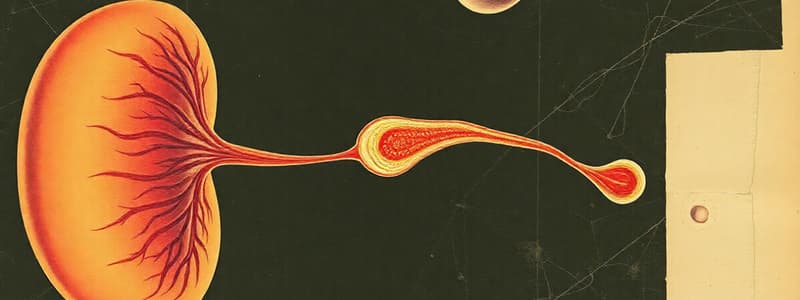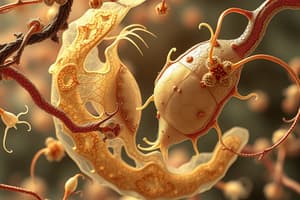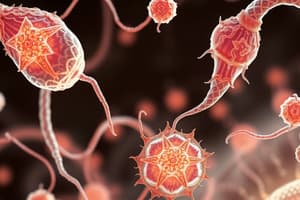Podcast
Questions and Answers
Which of the following correctly pairs a structure with its primary function in the female reproductive system?
Which of the following correctly pairs a structure with its primary function in the female reproductive system?
- Fallopian tube: Site of fertilization. (correct)
- Endometrium: Filter blood to nourish the developing fetus.
- Fimbriae: Propel the ovum through the uterus.
- Cervix: Produce estrogen and progesterone.
How does the function of Sertoli cells directly support spermatogenesis?
How does the function of Sertoli cells directly support spermatogenesis?
- By contracting to propel sperm through the seminiferous tubules.
- By providing structural support and nourishment to developing sperm cells. (correct)
- By producing testosterone to stimulate sperm maturation.
- By storing mature sperm until ejaculation.
Which hormone directly stimulates the testes to produce testosterone?
Which hormone directly stimulates the testes to produce testosterone?
- Gonadotropin-Releasing Hormone (GnRH)
- Follicle-Stimulating Hormone (FSH)
- Luteinizing Hormone (LH) (correct)
- Estrogen
How does the acrosome contribute to the sperm's function during fertilization?
How does the acrosome contribute to the sperm's function during fertilization?
Which process is directly facilitated by the production of pre-ejaculate fluid from the Cowper's gland?
Which process is directly facilitated by the production of pre-ejaculate fluid from the Cowper's gland?
How does the corpus luteum support early pregnancy?
How does the corpus luteum support early pregnancy?
What is the specific role of FSH in the male reproductive system?
What is the specific role of FSH in the male reproductive system?
Which structure provides the optimal thermal environment for sperm production?
Which structure provides the optimal thermal environment for sperm production?
How does the myometrium contribute to the birthing process?
How does the myometrium contribute to the birthing process?
Vasectomy is a procedure where a section of the vas deferens is removed. How does this prevent pregnancy?
Vasectomy is a procedure where a section of the vas deferens is removed. How does this prevent pregnancy?
Which of the following accurately describes the roles of both estrogen and progesterone?
Which of the following accurately describes the roles of both estrogen and progesterone?
How does the structure of the seminiferous tubules directly support their function?
How does the structure of the seminiferous tubules directly support their function?
Which of the following series of cell types correctly describes the progression of spermatogenesis?
Which of the following series of cell types correctly describes the progression of spermatogenesis?
How does GnRH influence the reproductive system?
How does GnRH influence the reproductive system?
How are the roles of the seminal vesicle and the prostate gland similar in the male reproductive system?
How are the roles of the seminal vesicle and the prostate gland similar in the male reproductive system?
Menopause involves a decrease in estrogen production by the ovaries. How does this hormonal change affect the female reproductive system?
Menopause involves a decrease in estrogen production by the ovaries. How does this hormonal change affect the female reproductive system?
How does the location of the epididymis contribute to its function?
How does the location of the epididymis contribute to its function?
If the fimbriae are damaged, what is the MOST likely consequence?
If the fimbriae are damaged, what is the MOST likely consequence?
Which hormone is responsible for triggering ovulation?
Which hormone is responsible for triggering ovulation?
A woman is experiencing difficulty conceiving due to a hormonal imbalance. Tests reveal that she has low levels of GnRH. How is this MOST likely affecting her fertility?
A woman is experiencing difficulty conceiving due to a hormonal imbalance. Tests reveal that she has low levels of GnRH. How is this MOST likely affecting her fertility?
Flashcards
Gamete
Gamete
A sex cell (sperm or egg) that contains half the number of chromosomes (haploid) and fuses during fertilization.
Ovum
Ovum
A mature female gamete (egg), produced in the ovaries.
Spermatogenesis
Spermatogenesis
The process by which sperm cells are produced in the testes.
Spermatogonia
Spermatogonia
Signup and view all the flashcards
Spermatocytes
Spermatocytes
Signup and view all the flashcards
Spermatids
Spermatids
Signup and view all the flashcards
Acrosome
Acrosome
Signup and view all the flashcards
Flagellum
Flagellum
Signup and view all the flashcards
Ovary
Ovary
Signup and view all the flashcards
Follicle
Follicle
Signup and view all the flashcards
Corpus luteum
Corpus luteum
Signup and view all the flashcards
Fallopian tube
Fallopian tube
Signup and view all the flashcards
Fimbriae
Fimbriae
Signup and view all the flashcards
Uterus
Uterus
Signup and view all the flashcards
Scrotum
Scrotum
Signup and view all the flashcards
Seminiferous tubule
Seminiferous tubule
Signup and view all the flashcards
Epididymis
Epididymis
Signup and view all the flashcards
Testosterone
Testosterone
Signup and view all the flashcards
FSH (Follicle-Stimulating Hormone)
FSH (Follicle-Stimulating Hormone)
Signup and view all the flashcards
LH (Luteinizing Hormone)
LH (Luteinizing Hormone)
Signup and view all the flashcards
Study Notes
Gametes
- Gametes are sex cells, either sperm or egg.
- They contain half the number of chromosomes, known as haploid.
- Gametes fuse during fertilization.
Ovum
- An ovum is a mature female gamete, also known as an egg.
- Ova are produced in the ovaries.
Spermatogenesis
- Spermatogenesis is the process by which sperm cells are produced in the testes.
Spermatogonia
- Spermatogonia are undifferentiated male germ cells in the testes.
- They divide to eventually form sperm.
Spermatocytes
- Spermatocytes develop from spermatogonia.
- They undergo meiosis to become spermatids.
Spermatids
- Spermatids are haploid cells resulting from meiosis of spermatocytes.
- They mature into sperm.
Acrosome
- The acrosome is a cap-like structure on the head of a sperm.
- It contains enzymes needed to penetrate the egg.
Flagellum
- The flagellum is a whip-like tail that enables sperm to swim.
Female Reproductive System: Ovary
- The ovary is a gland that produces eggs (ova).
- It produces female sex hormones, including estrogen and progesterone.
Female Reproductive System: Follicle
- A follicle is a fluid-filled sac in the ovary that contains an immature egg.
- It releases the egg during ovulation.
Female Reproductive System: Corpus Luteum
- The corpus luteum is a hormone-secreting structure that forms from the follicle after ovulation.
- It primarily produces progesterone.
Female Reproductive System: Fallopian Tube
- The fallopian tube carries the ovum from the ovary to the uterus.
- Fertilization usually occurs in the fallopian tube.
Female Reproductive System: Fimbriae
- Fimbriae are finger-like projections at the end of the fallopian tubes.
- They help sweep the egg into the tube.
Female Reproductive System: Uterus
- The uterus is a muscular organ where a fertilized egg implants and grows during pregnancy.
Female Reproductive System: Cervix
- The cervix is the lower part of the uterus that opens into the vagina.
- It dilates during childbirth.
Female Reproductive System: Endometrium
- The endometrium is the inner lining of the uterus.
- It thickens in preparation for pregnancy and sheds during menstruation.
Female Reproductive System: Myometrium
- The myometrium is the thick muscular layer of the uterus.
- It contracts during labor.
Female Reproductive System: Peritoneum
- The peritoneum is a membrane that lines the abdominal cavity.
- It covers the organs, including parts of the reproductive system.
Male Reproductive System: Testes (Testicles)
- The testes are organs that produce sperm and testosterone.
Male Reproductive System: Scrotum
- The scrotum is the external sac that holds the testes.
- It regulates the temperature of the testes.
Male Reproductive System: Seminiferous Tubule
- Seminiferous tubules are tiny tubes in the testes where spermatogenesis takes place.
Male Reproductive System: Sertoli Cells
- Sertoli cells are in the seminiferous tubules.
- They support and nourish developing sperm.
Male Reproductive System: Epididymis
- The epididymis is a coiled tube where sperm mature and are stored.
Male Reproductive System: Vas Deferens
- The vas deferens is a tube that transports mature sperm from the epididymis to the ejaculatory duct.
Male Reproductive System: Ejaculatory Duct
- The ejaculatory duct is where the vas deferens and seminal vesicle meet.
- Sperm travel through this before exiting the penis.
Male Reproductive System: Urethra
- The urethra is a tube that carries urine and semen out of the body through the penis.
Male Reproductive System: Seminal Vesicle
- The seminal vesicle is a gland that produces a sugar-rich fluid (semen).
- Semen provides energy for sperm.
Male Reproductive System: Prostate Gland
- The prostate gland produces a fluid that helps sperm survive in the acidic environment of the female reproductive tract.
Male Reproductive System: Cowper’s Gland (Bulbourethral Gland)
- The Cowper’s gland produces a pre-ejaculate fluid.
- This fluid lubricates and neutralizes acidity in the urethra.
Hormones: Estrogen
- Estrogen is a female sex hormone.
- It is responsible for the development of female secondary sex characteristics.
- It also regulates the menstrual cycle.
Hormones: Progesterone
- Progesterone is a hormone that maintains the uterine lining for pregnancy.
- It is produced mainly by the corpus luteum.
Hormones: FSH (Follicle-Stimulating Hormone)
- FSH stimulates follicle development in ovaries.
- It stimulates spermatogenesis in testes.
Hormones: LH (Luteinizing Hormone)
- LH triggers ovulation in females.
- It stimulates testosterone production in males.
Hormones: GnRH (Gonadotropin-Releasing Hormone)
- GnRH is produced by the hypothalamus.
- It stimulates the pituitary gland to release FSH and LH.
Hormones: Testosterone
- Testosterone is the primary male sex hormone.
- It is responsible for sperm production.
- It facilitates the development of male secondary sex characteristics.
Studying That Suits You
Use AI to generate personalized quizzes and flashcards to suit your learning preferences.




